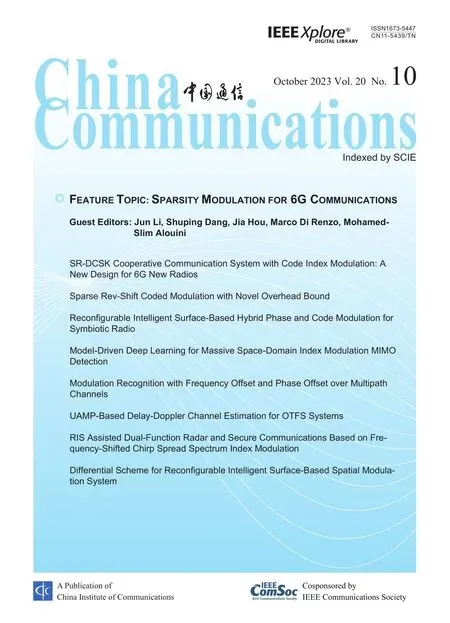SR-DCSK Cooperative Communication System with Code Index Modulation: A New Design for 6G New Radios
2023-11-06YiFangWangChenPingpingChenYiweiTaoMohsenGuizani
Yi Fang ,Wang Chen ,Pingping Chen ,Yiwei Tao ,Mohsen Guizani
1 School of Information Engineering,Guangdong University of Technology,Guangzhou 510006,China
2 School of Advanced Manufacturing,Fuzhou University,Jinjiang campus,362251,China
3 Department of Machine Learning,MBZUAI,Abu Dhabi,999041,UAE
*The corresponding author,email: ppchen.xm@gmail.com
Abstract: This paper proposes a high-throughput short reference differential chaos shift keying cooperative communication system with the aid of code index modulation,referred to as CIM-SR-DCSK-CC system.In the proposed CIM-SR-DCSK-CC system,the source transmits information bits to both the relay and destination in the first time slot,while the relay not only forwards the source information bits but also sends new information bits to the destination in the second time slot.To be specific,the relay employs an N-order Walsh code to carry additional log2N information bits,which are superimposed onto the SRDCSK signal carrying the decoded source information bits.Subsequently,the superimposed signal carrying both the source and relay information bits is transmitted to the destination.Moreover,the theoretical bit error rate (BER) expressions of the proposed CIMSR-DCSK-CC system are derived over additive white Gaussian noise(AWGN)and multipath Rayleigh fading channels.Compared with the conventional DCSKCC system and SR-DCSK-CC system,the proposed CIM-SR-DCSK-CC system can significantly improve the throughput without deteriorating any BER performance.As a consequence,the proposed system is very promising for the applications of the 6G-enabled lowpower and high-rate communication.
Keywords: differential chaos shift keying;cooperative communication;short reference;code index modulation;high throughput;bit error rate
I.INTRODUCTION
In wireless communications,multipath fading is the main factor affecting the system performance.One technique to tackle this problem is chaotic signal [1].Especially,when the channel is time-varying or suffers from multipath propagation,the chaotic communication can exhibit excellent error performance.As the most typical and popular chaotic modulation scheme,differential chaos shift keying (DCSK) [2] has attracted much attention over the past two decades because it does not require chaos synchronization for detection.Due to the robustness against multipath fading and low-power property,DCSK has been widely applied in short-range wireless communications,e.g.,wireless body area networks (WBANs) and wireless sensor networks(WSNs)[3,4].
At present,DCSK has been incorporated into more diverse communication scenarios,such as underwater acoustic communication system [5],orthogonal frequency division multiplexing(OFDM)system[6]and ultra-wideband communication system [7,8].Moreover,some powerful error-correction codes have been combined with DCSK systems to improve performance [9–12].However,for the conventional DCSK system [2],each data frame is divided into two time slots,one time slot is used to transmit referencechaotic signals,and the other time slot is used to transmit information-bearing signals.This structure results in low data rate,low spectral efficiency and waste of energy.Thereby,several feasible approaches have been proposed to address the above drawbacks.In particular,a short reference DCSK (SR-DCSK)scheme has been presented in [13] to effectively improve the data rate and energy efficiency by reducing the frame duration.An enhanced DCSK scheme has been designed in [14] to increase date rates and save transmission energy.Additionally,a high-efficiency DCSK scheme(HE-DCSK)has been presented in[15]to boost the energy efficiency by recycling reference sample.In [16],a multi-carrier DCSK (MC-DCSK)scheme,which can be seen as a parallel extension of the conventional DCSK scheme,has been conceived to achieve high data rate and energy efficiency.Moreover,the constellation-aidedM-ary DCSK system has been appeared to another effective method to achieve high data rate and high spectral efficiency[17–19].
Index modulation(IM)is a new emerging technique that can improve data rate and energy efficiency of wireless communication systems[20,21].In IM technique,various transmission resources such as spreading code,time slot,sub-carrier and transmit antenna can be used to carry information [22,23].The code index modulation(CIM)technique was first applied to direct-spread spectrum-sequence communication system in [24,25] to achieve the goal of increasing data rate.This technique also has potential to overcome the drawbacks of low data rate and energy efficiency of DCSK system.In recent years,there have been some research works touching upon the joint design of IM and DCSK[26–28].Especially,a new CIM-aided SRDCSK that uses a Walsh code to carry additional information bits,called CIM-DCSK,has been developed in[29]to obtain high data rate.Moreover,a hybrid modulation scheme integrating pulse position modulation(PPM)with DCSK has been presented in[30],which exploits the activation pattern of time slots to carry additional information bits.In[31],a carrier index modulation DCSK (CI-DCSK) scheme has been devised,which carries additional information bits by activating different sub-carriers.Furthermore,a dual-mode DCSK scheme with index modulation (DM-DCSKIM)has been proposed in[32]to exploit both inactive and active time slots to convey information bits,hence significantly boosting of data rate of the PPM-DCSK scheme.
As another promising anti-multipath-fading technique,spatial diversity has also attract much attention[33,34].Actually,the basic principle of spatial diversity is to mitigate the effect of multipath fading by transmitting redundant signal information via multiple antennas.Inspired by the advantage of spatial diversity,the joint design of DCSK and multiple-input multiple-output (MIMO) technique has been investigated in [35,36].Considering the cost and size of the equipments,the deployment of multiple antennas is desired in actual implementations.Hence,the cooperative communication,which realizes transmit diversity via the deployment of a relay between the source and destination,has been proposed as an alternative approach to combat the multipath fading [37].In the conventional cooperative communication system,the relay generally adopts amplify-and-forward (AF) or decode-and-forward (DF) protocol to transmit source information to the destination[38,39].In particular,in the half-duplex mode,the relay preferentially helps the source to forward the information and delays its own information transmission to the destination.As such,the relay needs to transmit its own information to the destination at the cost of extra time slots.To improve the transmission throughput,IM technique can be applied to cooperative communication.For instance,a distributed OFDM cooperative system with the aid of IM has been devised in[40],in which the information bits of source and relay can be transmitted simultaneously to the destination in each transmission period.
On the other hand,it has been demonstrated in[41–44] that combining DCSK with cooperative communication can greatly improve the reliability of wireless communication systems.In particular,a DCSK-based cooperative communication (DCSK-CC) system has been presented in [45],but it has a relatively lower data rate compared to the conventional DCSK system because an extra time slot is allocated to the relay for transmission.In[46],an efficient transmission scheme for DCSK-CC system has been devised,which exploits an efficient partial-sequence cooperative communication (PS-CC) scheme to solve the problem of low data rate.
To preserve the advantages of the DCSK-CC system while improving the data rate,we propose a highthroughput CIM-aided SR-DCSK cooperative communication system,referred to as CIM-SR-DCSK-CC system,in this paper.The contributions in this paper are summarized as follows:
1) In the proposed CIM-SR-DCSK-CC system,the source transmits information bits to the relay and the destination in the first time slot,while the relay transmits its own information bits and source information bits simultaneously to the destination in the second time slot.More specifically,we exploit the SR-DCSK to realize the communication between the source and destination,and employ the CIM-SR-DCSK to guarantee the communication request between the relay and destination without wasting additional time slots and energy.
2) We derive the theoretical bit error rate(BER)formulas of the proposed CIM-SR-DCSK-CC system over additive white Gaussian noise(AWGN)and multipath Rayleigh fading channels and verify their accuracy via Monte-Carlo simulations.
3) We compare the performance of the proposed CIM-SR-DCSK-CC system with other DCSK cooperative communication systems,i.e.,DCSKCC system and SR-DCSK-CC system.The results demonstrate that the proposed system can achieve similar BER performance as the two counterparts over AWGN and multipath Rayleigh fading channels,but achieves a significant improvement in terms of throughput.
In consequence,the proposed system has great potential to realize low-power high-rate transmissions in 6G-enabled applications.
The remainder of this paper is structured as follows.Section II briefly reviews conventional SR-DCSK system and presents the proposed CIM-SR-DCSK-CC system.Section III analyzes the BER and throughput performance of the CIM-SR-DCSK-CC system.Section IV presents simulation results and discussions.Finally,Section V draws the conclusion.
II.SYSTEM MODEL
This section first introduces the basic principle of SRDCSK system,and then describes the proposed highthroughput CIM-SR-DCSK-CC system model.
2.1 SR-DCSK System
The block diagram of the SR-DCSK transceiver is shown in Figure 1(a) and Figure 1(b) [13].As seen,the transmitted signal consists of a referencechaotic signal and an information-bearing signal.The second-order Chebyshev polynomial function(CPF),i.e.,xk+1=1 -is used to generate aU-length reference-chaotic signal x,where x=[x1,x2···,xU].Theβ-length information-bearing signal is generated by copying the reference-chaotic signalNtimes,whereβ=N·U.Thereby,the structure of an SR-DCSK signal can be obtained as Figure 1(c),and spreading factor is defined asSF=U+β=(N+1)U.For each transmitted symbolbl∈{+1,-1},the transmitted signal of thel-th symbol can be expressed as
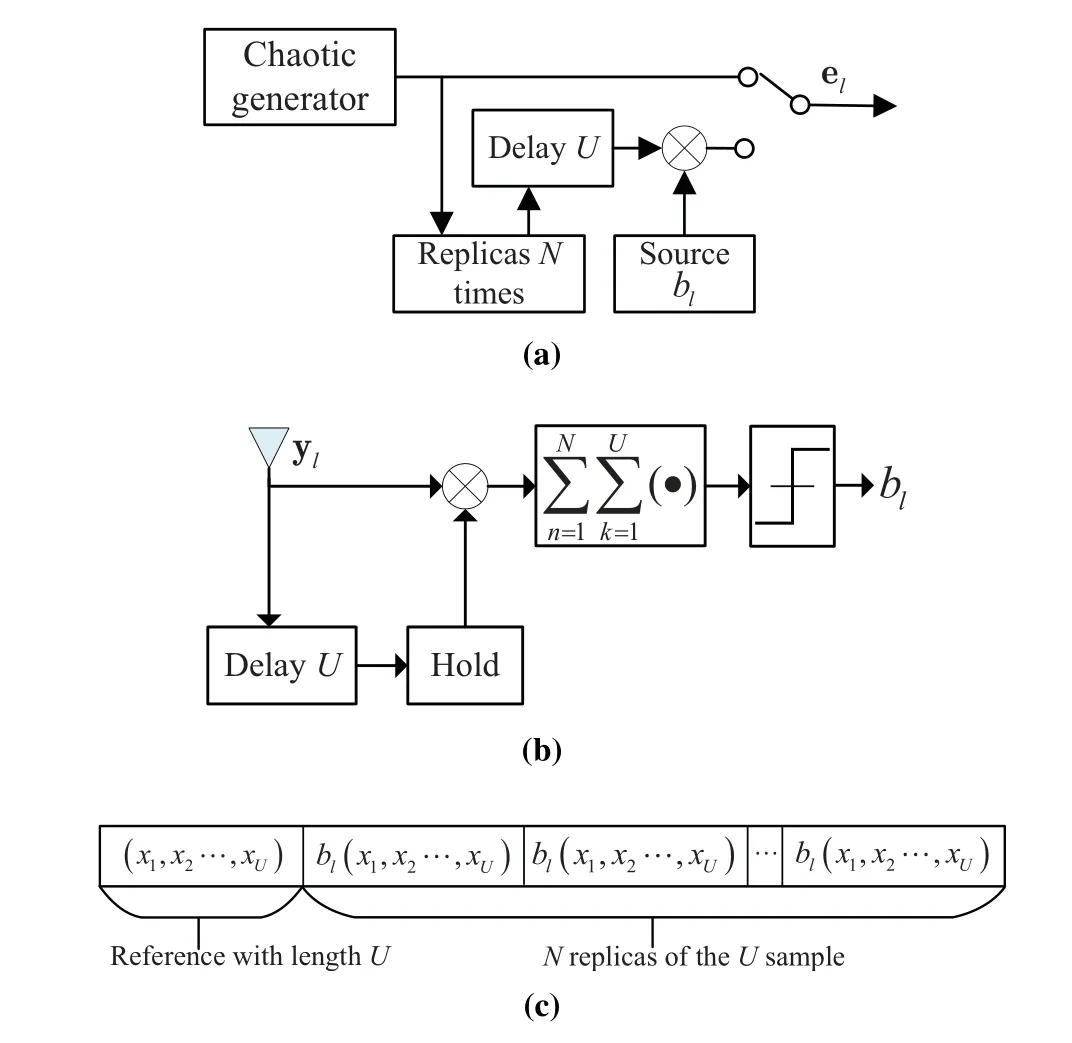
Figure 1.Structures of (a) SR-DCSK transmitter;(b) SRDCSK receiver;and(c)SR-DCSK signal.
where IN=[1,···,1]1×Nis a unit vector of lengthNand⊗represents the Kronecker product.
The transmitted signal passes through a wireless channel and then yields the received signal yl.The received reference-chaotic signal is correlated withNreplicas of information-bearing signal.Then,we can obtainNindependent correlation values and get the decision metric by summing these correlation values.Finally,the transmitted symbolblcan be estimated by comparing the decision metric with a zero threshold.
2.2 Proposed CIM-SR-DCSK-CC System
We consider a half-duplex cooperative communication system including a source node S,a destination node D,and a relay node R.In particular,we assume that both S and R need to transmit information bits to D,and R adopts the DF protocol.In this system,the information bit streams are composed of both modulated bit and index bits.The modulated bit and index bits are transmitted by S and R,respectively.There are two time slots in each transmission period.Specifically,the transmission period of the CIM-SRDCSK-CC system is(U+β)NpTc×2,whereNpis the number of information bit streams sent in each transmission period andTcis the chip time.In the first time slot,we take the transmission of thel-th information bit stream as an example.In this case,the modulated bit is first mapped to modulated symbolblat S.Then,blis carried by the SR-DCSK signal and transmitted to R and D simultaneously.In the second time slot,R adopts the DF protocol to recover the modulated symbolbland transmit a new chaotic signal to D.The new chaotic signal is formed by combining the SR-DCSK signal carrying modulated symbolbland a specific row vector of Walsh code.In particular,the choice of specific row vector is determined by index symbolal∈{1,2,...,N},which is the mapped by the index bits.Moreover,the numbermcof index bits is related to the numberNof replicas of the SR-DCSK signal,i.e.,mc=log2N.
As a further advance,Table 1 illustrates the mapping rule between the index bits and index symbolal(i.e.,row vector of Walsh code) in the proposed CIM-SRDCSK-CC system.Finally,D processes the signals transmitted from S and R to demodulate the overall information bits.Figure 2 depicts the proposed CIMSR-DCSK-CC system model.

Table 1.Illustration of the mapping rule between index bits and index symbol al (i.e.,row vector of Walsh code) in the proposed CIM-SR-DCSK-CC system.
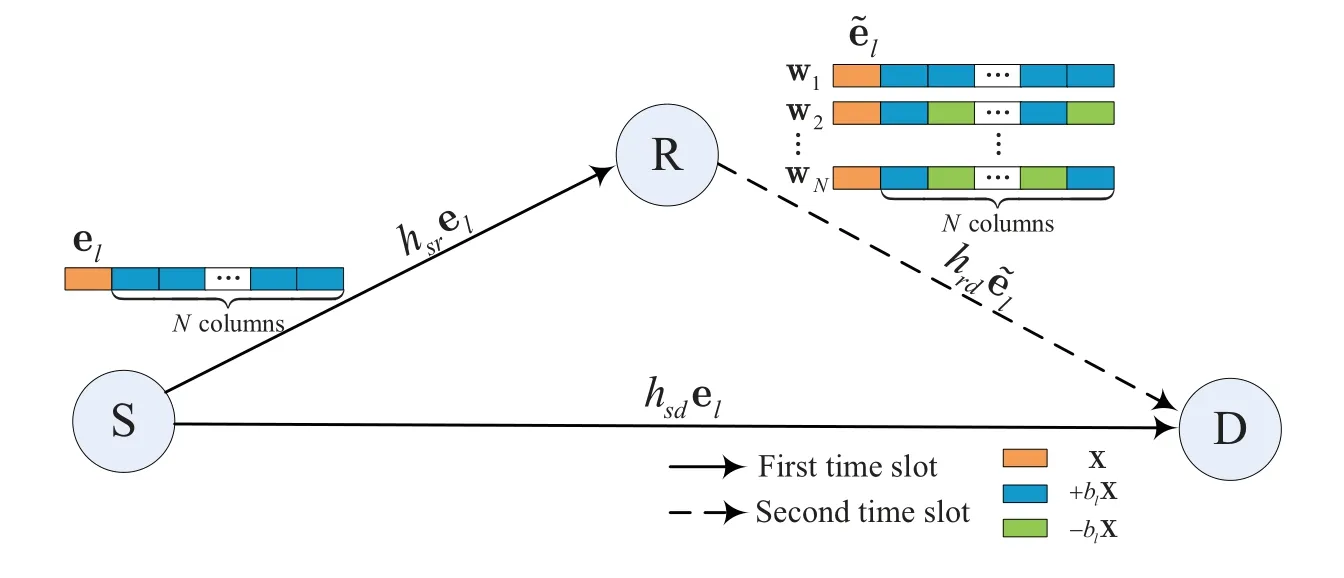
Figure 2.The proposed CIM-SR-DCSK-CC system model.
The transmitter of S is shown in Figure 1(a)and the transmitted signalesr(sd)is expressed as Eq.(1).In the first time slot,after passing through the multipath Rayleigh fading channels,the signals received by R and D can be respectively given by
wherePSis the transmit power at S,dsr(sd)is the distance between S and R (D),Lsr(sd)is the number of channel paths,αis the path loss coefficient,hsr(sd),landτsr(sd),lrepresent the channel coefficient and delay of thel-th path for S to R(D),respectively.Besides,thensr(sd),kdenotes the AWGN with zero mean and varianceN0,sr(sd)/2 for S→R(D)link.
On the one hand,the receiver structure at R is shown in Figure 1(b).Further,the decision metric of S→R link can be expressed as
Hence,ifZsr>0,the symbolblis estimated asbl=+1;otherwise,blis estimated asbl=-1.
On the other hand,the structure of receiver at D is shown in Figure 3.In the first time slot,we only need to perform the operation in the first branch of the detector to process the received signal of S→D link,then get the decision metric and store it.This operation is equivalent to SR-DCSK modulation,because the first row of Walsh code is all-ones vector,i.e.,w1=[+1,···,+1]1×N.Hence,the decision metric of S→D link can be expressed as
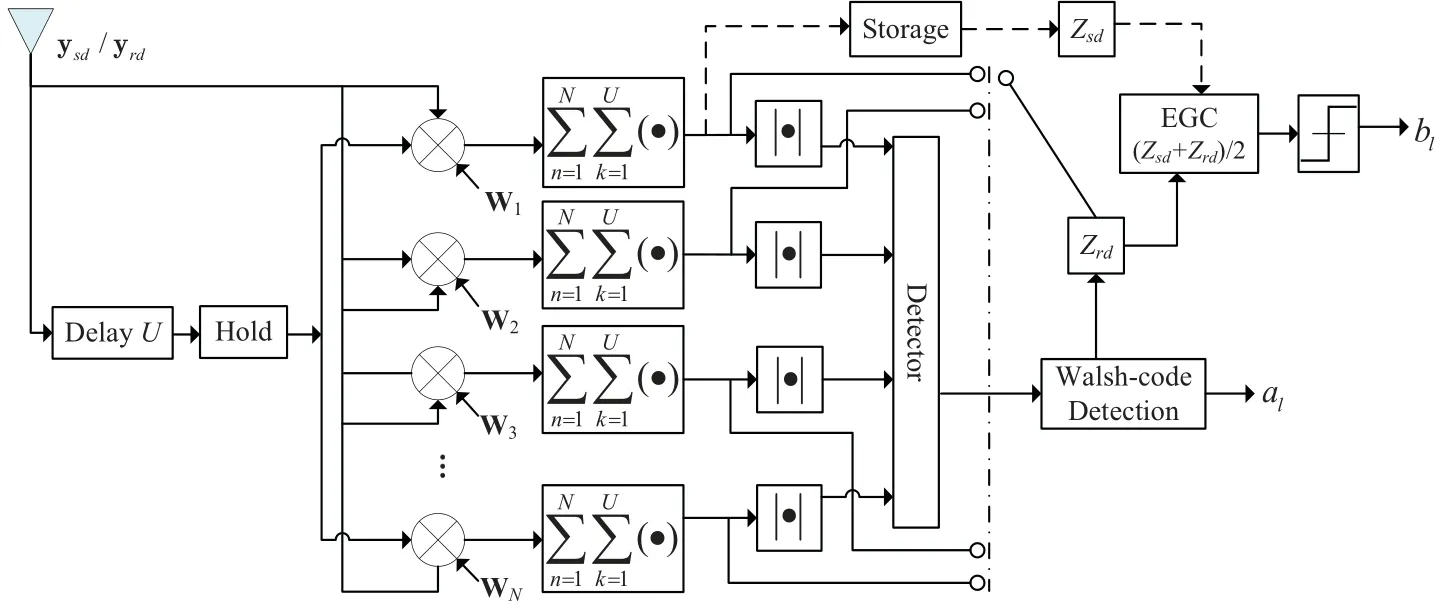
Figure 3.Structure of receiver at D in the proposed CIM-SR-DCSK-CC system.
In the second time slot,R transmits the decoded source information bit and its own information bits to D via the combination of SR-DCSK signal and a specific row vector of Walsh code.The structures of the transmitter and transmitted signal at R are shown in Figure 4(a) and Figure 4(b),respectively.To be specific,the transmitted signal of thel-th symbol is written as
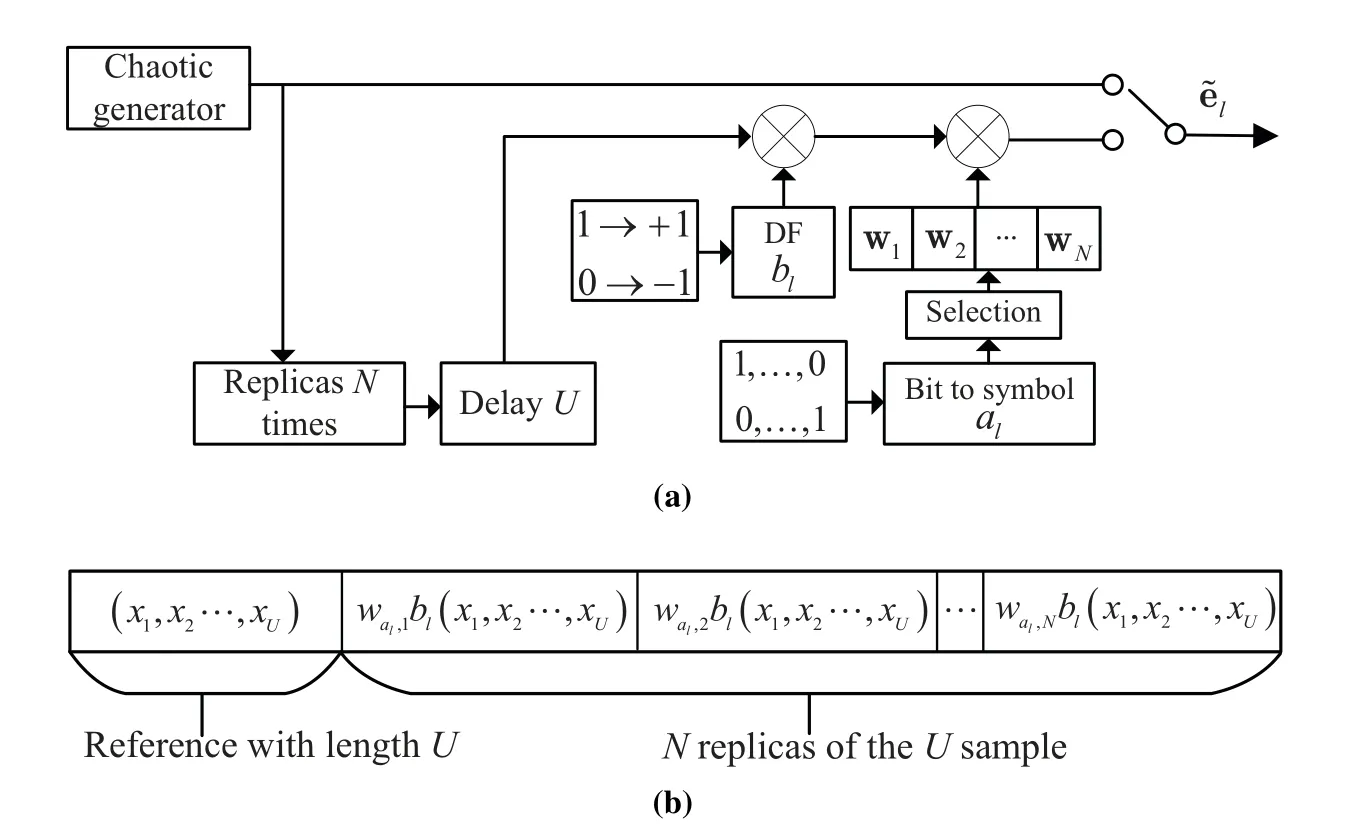
Figure 4.Structures of(a)transmitter and(b)transmitted signal at R in the proposed CIM-SR-DCSK-CC system.
where wal,Nrepresents theal-th row vector ofNorder Walsh code.After passing through the multipath Rayleigh fading channels,the signal received by D is yielded as
wherePRis the transmit power at R,drdis the distance between R and D,Lrdis the number of channel paths,hrd,landτrd,lrepresent the channel coefficient and delay of thel-th path for R to D,respectively.Besides,nrd,kdenotes the AWGN with zero mean and varianceN0,rd/2 for R→D link.
Then,we need to perform the operations of allNdetector branches to process the received signal of R→D link,as shown in Figure 3.Assume thatis the estimated index symbol output by the detector.If,the output of them-th (m=1,2,...,N)branch is formulated as
Otherwise,ifm=,the corresponding output becomes
To recover the index bits,the index symbolalcan be estimated by comparing the absolute values of Eq.(8)and Eq.(9),i.e.,
Hence,the decision metric of R→D link can be written asZrd=Zal.Furthermore,to recover the modulated bit,an equal-gain combiner(EGC)1is utilized to process the decision metrics of S→D and R→D links,the modulated symbolblcan be estimated as
III.PERFORMANCE ANALYSIS OF PROPOSED CIM-SR-DCSK-CC SYSTEM
3.1 BER Performance
3.1.1 Formulation of System BER
In the CIM-SR-DCSK-CC system,the overall BER is determined by the BER of index bits and the BER of modulated bit.Hence,the BER expression of the system can be written as
wherePcimandPmodare defined as the BERs of the index bits and modulated bit,respectively.
3.1.2 Derivation ofPcim
Pcimis related to the error probability of Walsh-code detection.More specifically,the probability of detecting any of theN-1 incorrect row vectors of a Walsh code is the same.Then,the expectation of the number of error bits is expressed as
wherePedis defined as the error probability of Walshcode detection.To obtainPed,we assume that the modulated symbolbl=+1 and the index symbol.Thus,the mean and the variance ofandZmin the R→D link are respectively formulated as
whereEsis defined as the average symbol energy of the system,i.e.,,andγrd=is the instantaneous signal-to-noise ratio(SNR)of R→D link.
where the erf(x) is error function.Subsequently,the mean and variance ofare calculated by
where
Assuming thatY1=max{|Zm|}andm=1,2···,N-1. The conditional error probability of Walsh-code detection is measured by
Actually,the proposed design criterion is independent of the fading distribution.To illustrate the advantage of the proposed system in a simple and clear way,we consider the multipath Rayleigh fading channel here,as in [13–16].We assume thatLυchannel coefficients are independent and identically distributed random variables over a multipath Rayleigh fading channel.Moreover,we assume that the average power gains of theLvare equal,i.e.,=...=,whereυ∈{sr,sd,rd}.Hence,the PDF of instantaneous SNRγυcan be written as[26,48]
Besides,forLυindependent Rayleigh fading channels with unequal power delay profiles,the PDF ofγυcan be written as[49]
Finally,the average error probability of Walsh-code detection becomes
3.1.3 Derivation ofPmod
The modulated bit transmitted from S and forwarded by R is recovered at D.We first need to analyze the error probability of DF protocol,which is dependent on the erroneous detection of SR-DCSK at R.To get the the decision metric(i.e.,Zsr)of SR-DCSK detection,one can get the mean and variance ofZsr,respectively,as
According to the central limit theorem,the decision metricZsrfollows the normal distribution [13],the conditional error probability of DF protocol can be computed as
where erfc(x)is the complementary error function andis the instantaneous SNR of S→R link.The average error probability of DF protocol becomes
At D,we utilize EGC to obtain the decision metricZegcof the modulated bit.Actually,the decision metric can be calculated by the those of S→D and R→D links,i.e.,Zegc=(Zsd+Zrd)/2.When the Walshcode detection is correct,the decision metric of R→D link can be written asZrd=,the decision metric is expressed asZegc=(Zsd+)/2;otherwise,Zrd=Zm(m∈{1,2,···,N}andm),the decision metric becomes becomesZegc=(Zsd+Zm)/2.Thus,the mean and variance of the decision metric conditioned on correct detection at D are respectively given by
On the contrary,the mean and variance of the decision metric conditioned on erroneous detection at D are respectively give by
For the BER calculation of modulated bit,there are four possible cases occurring in CIM-SR-DCSK-CC system.Specifically,the four cases are defined as follows:
As such,the BER of modulated bit can be calculated as
where Pr(Θ=1),Pr(Θ=2),Pr(Θ=3),and Pr(Θ=4) represent the occurrence probabilities of case 1,case 2,case 3,and case 4,respectively.P(e|Θ=1),P(e|Θ=2),P(e|Θ=3),andP(e|Θ=4)represent the conditional BERs in case 1,case 2,case 3,and case 4,respectively.In particular,the conditional BERs of the latter two are equal,i.e.,P(e|Θ=3)=P(e|Θ=4),because their decision metrics obey the same normal distribution.On the one hand,the occurrence probabilities of four cases are computed as
On the other hand,the conditional BERs of four cases are calculated in(31),whereis the instantaneous SNR of S→D link.As such,the BER of modulated bit can be finally derived by substituting Eq.(30)and Eq.(31)into Eq.(29).
3.2 Transmission Throughput
As in [49],we define that the normalized throughput is the ratio of the successfully received bits/second of a given DCSK system to the transmitted bits/second of the proposed CIM-SR-DCSK-CC system.According to Sect.2.2,the proposed CIM-SR-DCSK-CC system can transmitNpinformation bit streams in each transmission period(i.e,=(U+β)NpTc×2).
Therefore,the normalized throughput can be formulated as
IV.SIMULATION RESULTS AND DISCUSSIONS
In this section,a variety of simulations are carried out to evaluate the performance of the proposed CIMSR-DCSK-CC system over AWGN and multipath Rayleigh fading channels,which verify the theoretical derivations in the previous section.We also compare the performance of the proposed system with the existing DCSK-CC system [42,50] and SR-DCSK-CC system to illustrate the advantage of our design.Unless otherwise mentioned,in the simulations,we set the spreading factor asSF=510,the transmit power of S and R asPS=PR=1W.Without loss of generality,we assume that the path loss coefficientα=2[41,46,51],the noise variances of S→R link,R→D link,and S→D link asN0,sr=N0,rd=N0,sd=N0,and their corresponding distances asdsr=drd=1m,dsd=2m.For the multipath Rayleigh fading channel,we consider three component paths with the following parameter setting: the average power gains are=1/3,and the path delays areτυ,1=0,τυ,2=Tc,τυ,3=2Tc,whereυ∈{sr,sd,rd}.
4.1 Verification of Theoretical BER Analysis
Figure 5 shows the simulated and theoretical BER performance of the proposed CIM-SR-DCSK-CC system over AWGN and multipath Rayleigh fading channels.Obviously,we can see that the simulated and theoretical BER curves are well consistent with each other.Besides,the BER performance of the proposed system gets worse with the increase ofmc.Actually,the system can allow the relay to transmit additional information bits at the price of sacrificing some BER performance.As a result,one should strike a balance between the error performance and data rate for the CIM-SR-DCSK-CC systems in practical applications.
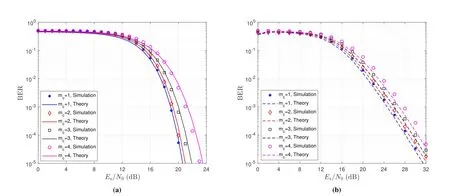
Figure 5.Simulated and theoretical BER performance of the proposed CIM-SR-DCSK-CC system over(a)AWGN and(b)multipath Rayleigh fading channels,where mc=1,2,3,4.
4.2 Discussion on the Influence of Placement of R on BER Performance
As a further advance,we investigate the influence of the distancedsrbetween S and R (resp.drd) on the BER performance of the proposed CIM-SR-DCSKCC system over an AWGN channel whenEs/N0=22 dB,as shown in Figure 6.In this figure,we assume that the distance between S and D isdsd=3m,whiledsris varying from 1m to 2m(i.e.,drdis varying from 2m to 1m).As seen,for a given number of index bits(i.e.,a given value ofmc),the BER performance of the CIM-SR-DCSK-CC system first improves and then deteriorates asdsrincreases.It is because that as R moves away from S (i.e.,R gets closer to D),the BER of system is mainly dependent on the BER of index bits in the initial stage,but not the BER of the modulated bit (see Eq.(12)).Nevertheless,oncedsrexceeds a certain value,the BER of modulated bit,instead of the BER of index bits,plays an more important role on the BER of system.In this stage,the probability of successful decoding at R is greatly reduced,leading to a severe degradation in the BER of modulated bit.Hence,the BER of system becomes worse in this stage.Besides,one can observe that the simulated BER curves agree well with the theoretical ones asdsrvaries,which further validate the accuracy of theoretical BER derivation.Simulations have also performed over a multipath Rayleigh fading channel and similar observations have been obtained.
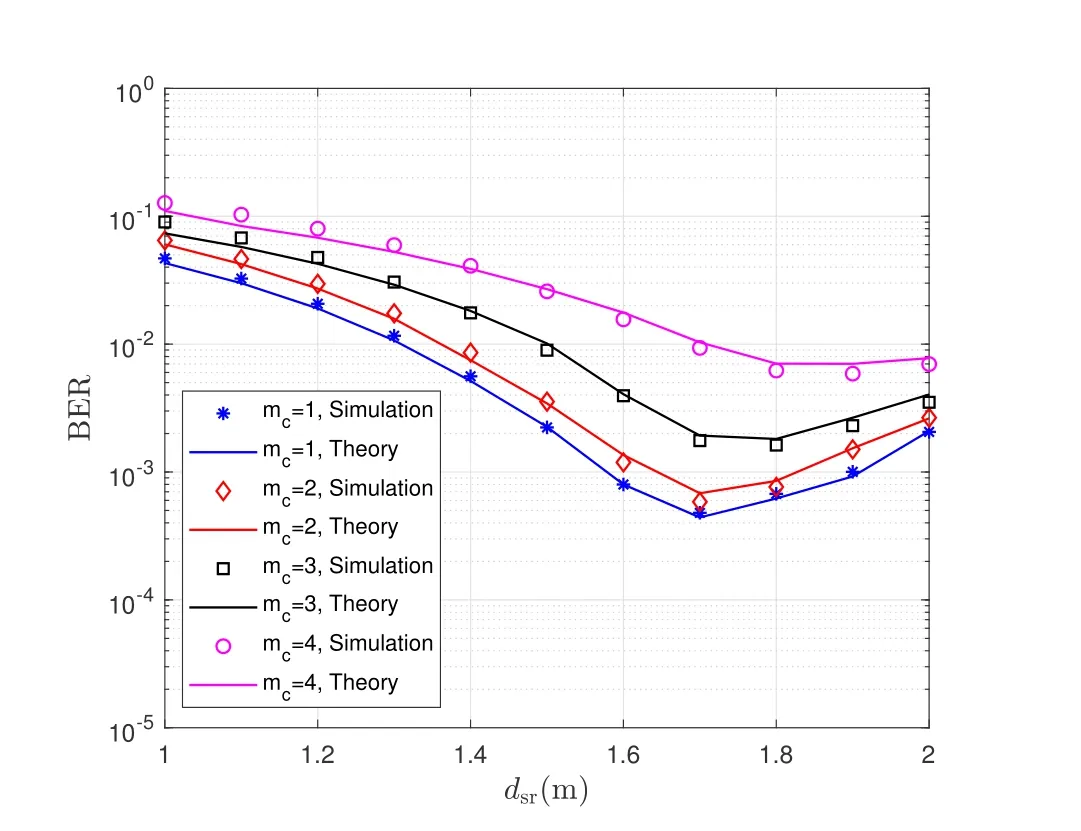
Figure 6.Simulated and theoretical BER performance of the proposed CIM-SR-DCSK-CC system versus dsr over an AWGN channel,where Es/N0=22 dB and mc=1,2,3,4.
4.3 BER Comparison Among the Proposed CIM-SR-DCSK-CC System,DCSK-CC System,and SR-DCSK-CC System
In the proposed CIM-SR-DCSK-CC system,both the source and relay can transmit their own information bits to the destination separately.However,in the two baselines (i.e.,the DCSK-CC system and SRDCSK-CC system),only the source transmits its own information bits to the destination.Hence,to guarantee a fair performance comparison,we consider the following transmission mechanism for the above two DCSK-CC systems.In the considered mechanism,the DCSK-CC system and SR-DCSK-CC system require two time slots to transmit the source information bits and spend an additional time slot to transmit the relay information bits.Since the relay in either the DCSKCC system or SR-DCSK-CC system can transmit only one information bit in the third time slot,we also assume that in the proposed CIM-SR-DCSK-CC system the relay transmits one index bit(i.e.,mc=1)for the sake of fairness.Moreover,we assume that the total transmission energyETfor all the three systems are identical.
Based on the above assumption,Figure 7 shows the BER performance of the source information bits and relay information bits in the proposed CIM-SRDCSK-CC system,the DCSK-CC system and the SR-DCSK-CC system over AWGN and multipath Rayleigh fading channels.In Figure 7(a),it can be seen that the BER performance of the source information bit in the proposed CIM-SR-DCSK-CC system is better than those in DCSK-CC system and SR-DCSKCC system over AWGN and multipath Rayleigh fading channels.This is because that the relays in the DCSK-CC system and SR-DCSK-CC system needs some energy to transmit their own information bits,while the relay in the CIM-SR-DCSK-CC system does not need additional energy to transmit its own information bit.As a result,the CIM-SR-DCSK-CC system has more energy to transmit the source information bits with respect to the other two counterparts.Referring to Figure 7(b),the CIM-SR-DCSK-CC system has better BER performance of the relay information bit than the DCSK-CC system,but worse than SR-DCSK-CC system over both channels.This phenomenon is due to the fact that the BER of relay information bit in the CIM-SR-DCSK-CC system is affected by the Walsh-code detection compared to SRDCSK-CC system.
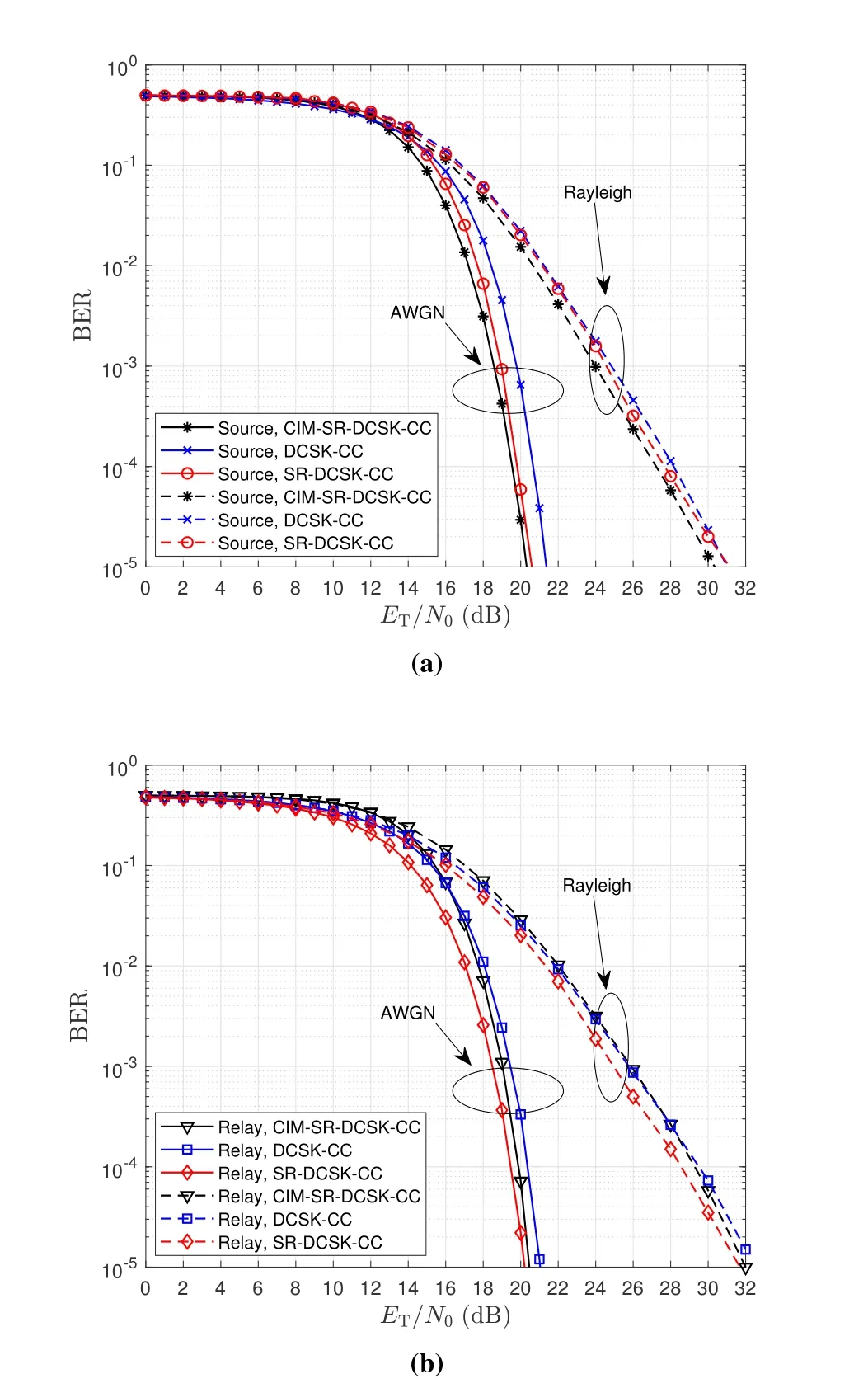
Figure 7.BER performance of the (a) source information bits and (b) relay information bits in the proposed CIMSR-DCSK-CC system,the DCSK-CC system,and the SRDCSK-CC system over AWGN and multipath Rayleigh fading channels.
Figure 8 shows the overall BER performance of the proposed CIM-SR-DCSK-CC system,DCSK-CC system and SR-DCSK-CC system over AWGN and multipath Rayleigh fading channels.The BER performance of the proposed CIM-SR-DCSK-CC system is similar to that of the SR-DCSK-CC system,both of which are better than that of DCSK-CC system over an AWGN channel.In addition,the BER performance of the CIM-SR-DCSK-CC system is slightly better than that of DCSK-CC system and SR-DCSK-CC system over a multipath Rayleigh fading channel.For example,the proposed CIM-SR-DCSK-CC system achieves a gain of 0.5 dB compared with the DCSK-CC system at a BER of 10-5over AWGN and multipath Rayleigh fading channels.Actually,the BER performance of CIMSR-DCSK-CC system is better than that of DCSKCC system from both the source-information-bit and relay-information-bit perspectives.
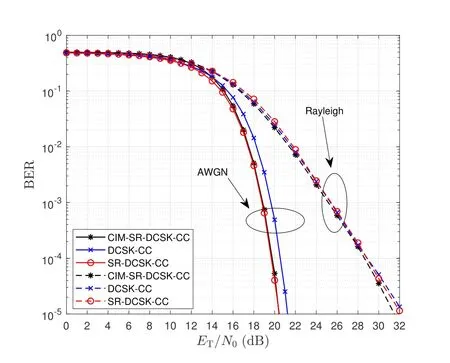
Figure 8.Overall BER performance of the proposed CIMSR-DCSK-CC system,the DCSK-CC system,and the SRDCSK-CC system over AWGN and multipath Rayleigh fading channels.
4.4 Throughput Comparison Among the Proposed CIM-SR-DCSK-CC System,DCSKCC System,and SR-DCSK-CC System
The normalized throughputs of the proposed CIMSR-DCSK-CC system,the DCSK-CC system,and the SR-DCSK-CC system over AWGN and multipath Rayleigh fading channels are presented in Figure 9.It can be observed that the normalized throughput of the proposed CIM-SR-DCSK-CC system is much higher than those of the DCSK-CC system and SR-DCSKCC system.For example,atET/N0=30 dB,the normalized throughput of the proposed CIM-SR-DCSKCC system is 1 over AWGN and multipath Rayleigh fading channels,while those of the DCSK-CC system and SR-DCSK-CC system are 1/2 and 2/3,respectively.This is because that the proposed system has a great improvement in time duration for information transmission with respect to the other two counterparts.
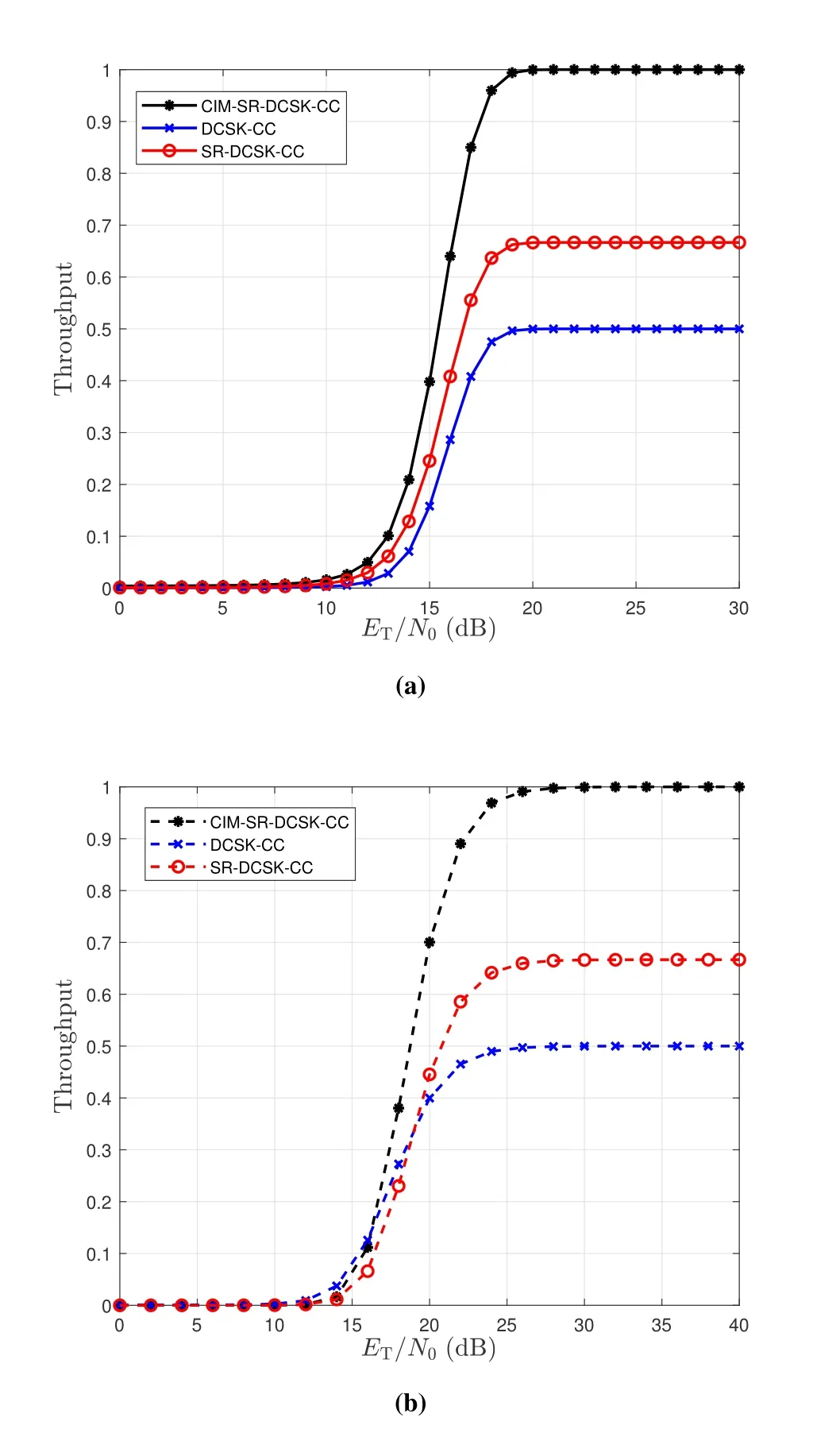
Figure 9.Normalized throughputs of the proposed CIMSR-DCSK-CC system,the SR-DCSK-CC system,and the DCSK-CC system over (a) AWGN and (b) multipath Rayleigh fading channels.
Remark 1.AlthoughtheaforementionedBERresultsareobtainedunderagivenparametersetting,simulationshavealsobeencarriedoutwith otherparametersettings(i.e.,differentSF,PS,PR,dv,α,E{},andτv,l)tosubstantiallyverifytheadvantageoftheproposedCIM-SR-DCSCK-CCsystem.
V.CONCLUSION
In this paper,we put forward a code-indexmodulation-aided SR-DCSK-CC system,namely CIM-SR-DCSK-CC system,to achieve highthroughput transmissions.In the proposed system,the relay not only forwards the source information bit to the destination,but also employs a Walsh code to convey additional information bits simultaneously.As a further advance,we analyzed the theoretical BER expressions and throughput of the proposed CIM-SR-DCSK-CC system over AWGN and multipath Rayleigh fading channels,which are in good agreement with the simulation results.Compared with the DCSK-CC system and SR-DCSK-CC system,the proposed CIM-SR-DCSK-CC system exhibits significant improvements in throughput without sacrificing any BER performance.Owing to the appealing advantages,the proposed CIM-SR-DCSK-CC system can be expected to be a competitive alternative for the 6G-enabled low-power and high-rate applications.
ACKNOWLEDGEMENT
This work was supported in part by the NSF of China under Grant 62322106,62071131 and 62171135,the Guangdong Basic and Applied Basic Research Foundation under Grant 2022B1515020086,the NSF of Guangdong Province under Grant 2019A1515011465,the International Collaborative Research Program of Guangdong Science and Technology Department under Grant 2022A0505050070,and the Industrial R&D Project of Haoyang Electronic Co.,Ltd.under Grant 2022440002001494.
NOTES
1The proposed CIM-SR-DCSK-CC system can achieve desirable performance without requiring any channel state information (CSI),thus it is appropriate to employ a simpler combiner,e.g.,equal-gain combiner (EGC).If the maximum ratio combiner(MRC) is employed,the system requires to estimate the CSI at receiver,which significantly increases the implementation complexity.
2For comparison,we establish an SR-DCSK-CC system by combining the SR-DCSK [13] with cooperative communication technique as a new baseline.
杂志排行
China Communications的其它文章
- Learning-Based Dynamic Connectivity Maintenance for UAV-Assisted D2D Multicast Communication
- AIGC Scenario Analysis and Research on Technology Roadmap of Internet Industry Application
- Dynamic Visible Light Positioning Based on Enhanced Visual Target Tracking
- Ultra Dense Satellite-Enabled 6G Networks: Resource Optimization and Interference Management
- Analysis and Optimization of Validation Procedure in Blockchain-Enhanced Wireless Resource Sharing and Transactions
- Anti-Jamming and Anti-Eavesdropping in A2G Communication System with Jittering UAV
